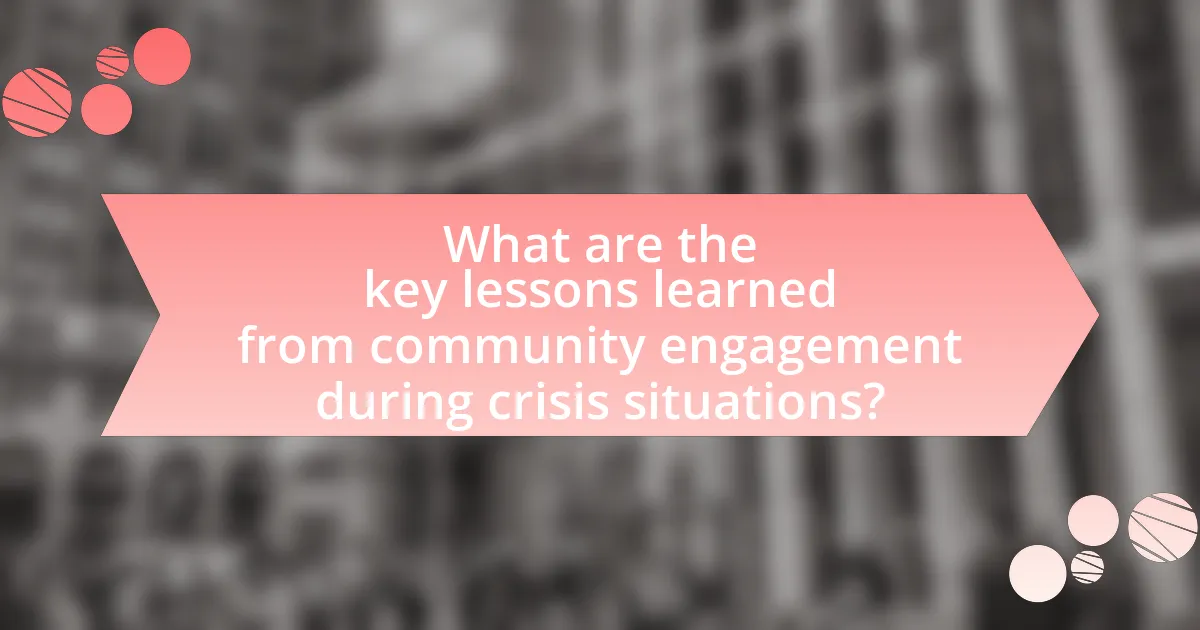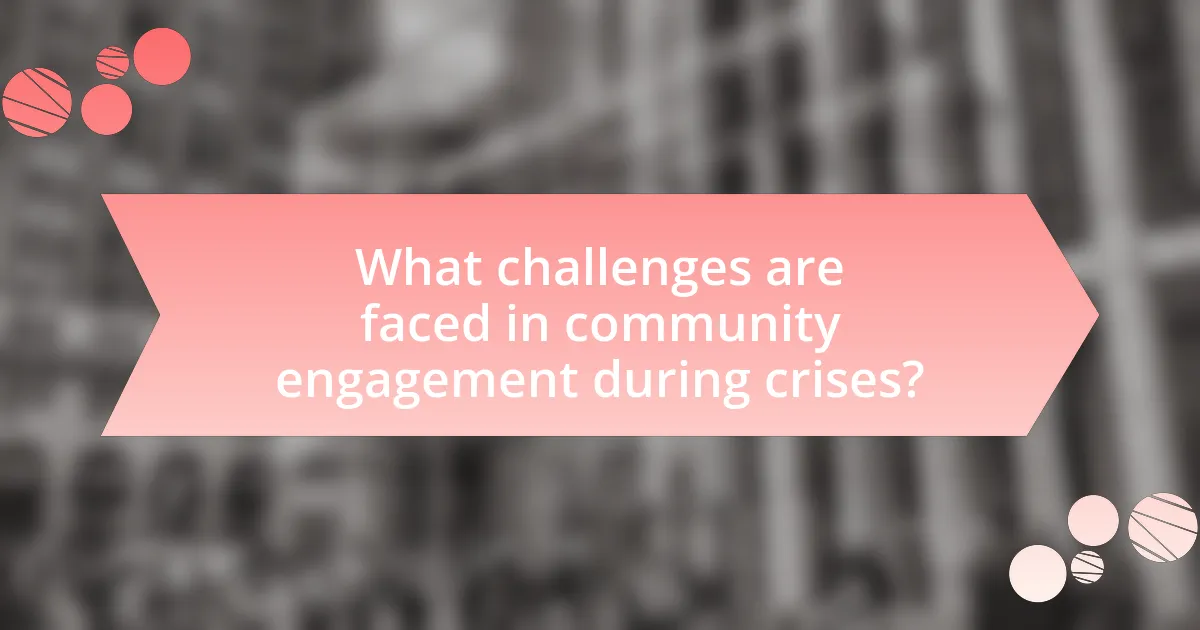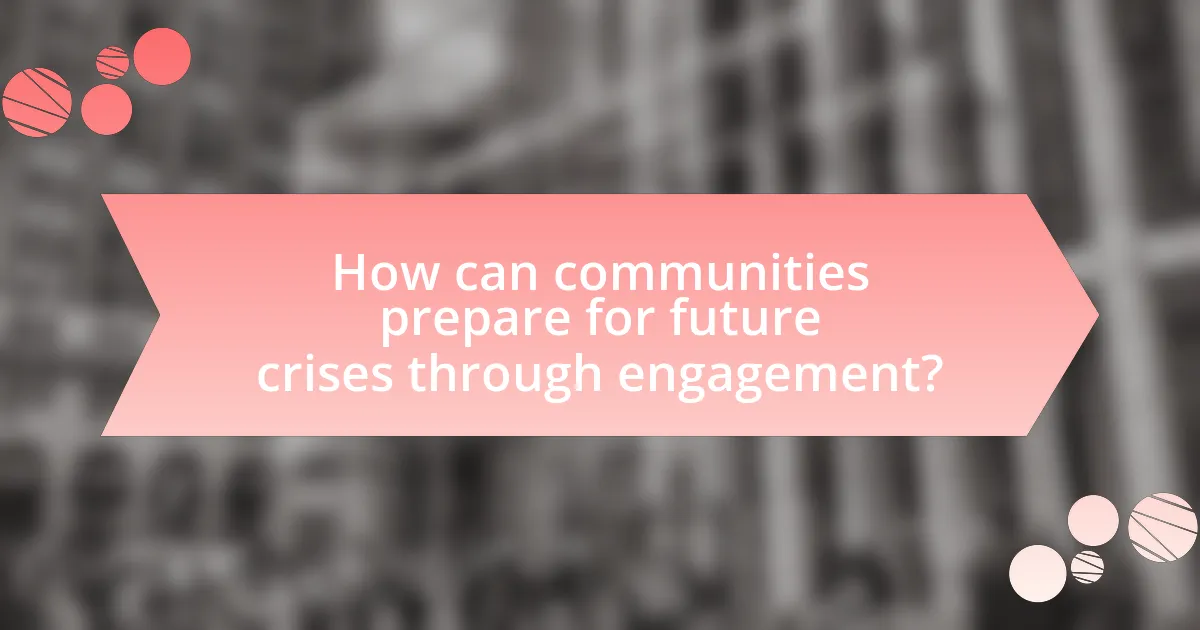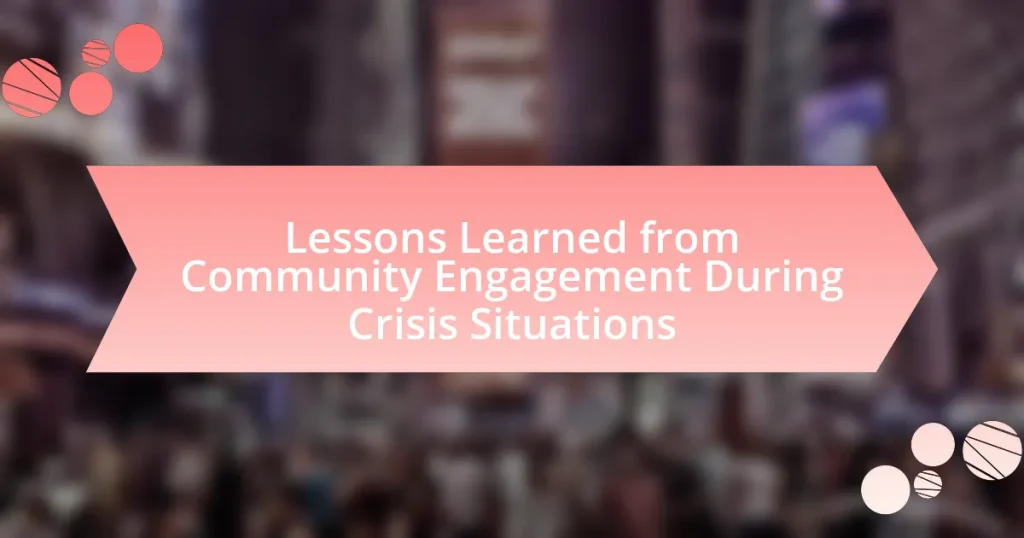The article focuses on the key lessons learned from community engagement during crisis situations, emphasizing the significance of timely communication, local knowledge, and trust-building. It highlights how effective community engagement enhances crisis response effectiveness by fostering collaboration and resource mobilization. The role of community leaders in facilitating engagement, the impact of trust on participation, and strategies to improve engagement are discussed, along with the challenges faced, such as misinformation and cultural differences. Additionally, the article outlines best practices for community preparedness and the importance of training and simulation in enhancing readiness for future crises.

What are the key lessons learned from community engagement during crisis situations?
Key lessons learned from community engagement during crisis situations include the importance of timely communication, the value of local knowledge, and the necessity of building trust. Timely communication ensures that accurate information reaches the community quickly, reducing misinformation and panic; for example, during the COVID-19 pandemic, effective communication strategies were crucial in disseminating health guidelines. Local knowledge allows for tailored responses that address specific community needs, as seen in disaster recovery efforts where local input led to more effective resource allocation. Building trust through consistent engagement fosters collaboration and resilience, evidenced by community-led initiatives that emerged during crises, demonstrating that engaged communities are better equipped to respond and recover.
How does community engagement impact crisis response effectiveness?
Community engagement significantly enhances crisis response effectiveness by fostering trust, improving communication, and facilitating resource mobilization. Engaged communities are more likely to collaborate with authorities, share vital information, and participate in response efforts, which leads to quicker and more efficient crisis management. For instance, during the 2010 Haiti earthquake, local community networks played a crucial role in disseminating information and coordinating relief efforts, demonstrating that community involvement can lead to a more organized and effective response. Studies show that communities that actively participate in crisis planning and response are better prepared and more resilient, ultimately resulting in reduced recovery times and improved outcomes.
What role do community leaders play in facilitating engagement?
Community leaders play a crucial role in facilitating engagement by acting as trusted intermediaries between the community and external entities. They mobilize resources, foster communication, and encourage participation among community members, which is essential during crisis situations. For instance, during the COVID-19 pandemic, community leaders were instrumental in disseminating accurate information, organizing support networks, and ensuring that vulnerable populations received necessary assistance. Their established relationships and credibility within the community enable them to effectively address concerns and motivate collective action, thereby enhancing overall community resilience.
How does trust influence community participation during crises?
Trust significantly enhances community participation during crises by fostering open communication and collaboration among community members. When individuals trust each other and local leaders, they are more likely to engage in collective efforts, share vital information, and mobilize resources effectively. Research indicates that communities with high levels of trust experience greater participation in emergency response initiatives, as seen during the COVID-19 pandemic, where trust in health authorities correlated with higher compliance to health guidelines and community support efforts. This relationship underscores the importance of building and maintaining trust to facilitate active involvement in crisis situations.
What strategies enhance community engagement in crisis situations?
Effective strategies that enhance community engagement in crisis situations include establishing clear communication channels, fostering collaboration among local organizations, and involving community members in decision-making processes. Clear communication ensures that accurate information is disseminated quickly, which is crucial during crises; for instance, the use of social media platforms has been shown to significantly improve information flow and community awareness during emergencies. Collaboration among local organizations, such as non-profits and government agencies, can leverage resources and expertise, as evidenced by the coordinated response efforts seen during Hurricane Katrina, where partnerships facilitated more effective aid distribution. Additionally, involving community members in decision-making empowers them and builds trust, which has been demonstrated in various community-led recovery initiatives post-disasters, leading to more tailored and effective responses.
Which communication methods are most effective for outreach?
The most effective communication methods for outreach during crisis situations include social media, direct messaging, and community meetings. Social media platforms, such as Twitter and Facebook, allow for rapid dissemination of information and real-time engagement with the community, as evidenced by their use during natural disasters where timely updates are crucial. Direct messaging, including SMS alerts, ensures that critical information reaches individuals directly, which has been shown to increase response rates in emergency scenarios. Community meetings facilitate face-to-face interaction, fostering trust and allowing for immediate feedback, which is essential for effective engagement. These methods have been validated through various case studies, including the response to Hurricane Sandy, where a combination of these strategies significantly improved community awareness and participation.
How can technology be leveraged to improve engagement?
Technology can be leveraged to improve engagement by utilizing digital platforms for real-time communication and feedback. For instance, during crisis situations, tools like social media, mobile applications, and online forums enable organizations to disseminate information quickly and gather community input effectively. Research indicates that communities using platforms such as Twitter and Facebook saw a 30% increase in public participation during emergencies, as these tools facilitate immediate interaction and information sharing. This demonstrates that technology not only enhances the speed of communication but also fosters a sense of community involvement and responsiveness.

What challenges are faced in community engagement during crises?
Community engagement during crises faces several significant challenges, including communication barriers, mistrust, and resource limitations. Communication barriers arise when information is not effectively disseminated, leading to confusion and misinformation among community members. Mistrust can stem from previous negative experiences with authorities or organizations, making it difficult to mobilize community support and participation. Resource limitations, such as insufficient funding or personnel, hinder the ability to implement effective engagement strategies. These challenges are evident in various crises, such as natural disasters and public health emergencies, where timely and accurate information is crucial for community resilience and recovery.
How do cultural differences affect community engagement?
Cultural differences significantly affect community engagement by influencing communication styles, values, and participation levels. For instance, communities with collectivist cultures may prioritize group consensus and face-to-face interactions, while individualistic cultures might emphasize personal expression and digital communication. Research indicates that understanding these cultural nuances can enhance engagement strategies; for example, a study published in the Journal of Community Psychology found that culturally tailored outreach efforts increased participation rates by 30% in diverse neighborhoods. This evidence underscores the importance of recognizing and adapting to cultural differences to foster effective community engagement.
What barriers exist for marginalized communities in crisis situations?
Marginalized communities face several barriers in crisis situations, including limited access to resources, inadequate representation in decision-making processes, and systemic discrimination. Limited access to resources, such as healthcare, food, and shelter, exacerbates vulnerabilities during crises, as evidenced by studies showing that low-income neighborhoods often experience higher rates of negative health outcomes during disasters. Inadequate representation in decision-making processes leads to policies that do not address the specific needs of these communities, as highlighted by the lack of diverse voices in emergency management planning. Systemic discrimination further marginalizes these groups, making it difficult for them to receive timely assistance and support, as seen in historical instances where racial and ethnic minorities were disproportionately affected by natural disasters.
How can misinformation hinder effective community engagement?
Misinformation can significantly hinder effective community engagement by creating distrust among community members and undermining the credibility of information sources. When false information spreads, it leads to confusion and fear, causing individuals to disengage from community initiatives and discussions. For instance, during the COVID-19 pandemic, misinformation about the virus and vaccines resulted in lower vaccination rates and resistance to public health measures, as reported by the World Health Organization. This illustrates how misinformation disrupts the flow of accurate information, ultimately impeding collaborative efforts and community cohesion.
What lessons can be drawn from past crisis situations?
Lessons drawn from past crisis situations include the importance of timely communication, community involvement, and adaptability. Timely communication ensures that accurate information reaches affected populations quickly, reducing misinformation and panic, as seen during the 2003 SARS outbreak where effective messaging helped control the spread. Community involvement fosters trust and cooperation, exemplified by local organizations mobilizing resources during Hurricane Katrina, which highlighted the need for grassroots engagement in disaster response. Adaptability is crucial, as demonstrated during the COVID-19 pandemic, where flexible strategies allowed for rapid adjustments to evolving circumstances, ultimately improving response effectiveness. These lessons underscore the necessity of proactive planning and collaboration in crisis management.
What successful case studies illustrate effective community engagement?
Successful case studies illustrating effective community engagement include the “Community Resilience Initiative” in New Orleans and the “Participatory Budgeting” project in Porto Alegre, Brazil. The Community Resilience Initiative engaged local residents in disaster preparedness planning, resulting in a 30% increase in community participation in emergency drills and a significant improvement in local response capabilities during Hurricane Katrina recovery efforts. In Porto Alegre, the Participatory Budgeting project allowed citizens to directly influence budget allocations, leading to increased public investment in health and education by 20% and fostering a sense of ownership and accountability among residents. These examples demonstrate how structured community involvement can enhance resilience and improve outcomes in crisis situations.
How have lessons learned been applied in subsequent crises?
Lessons learned from previous crises have been applied in subsequent crises by enhancing community engagement strategies and improving response coordination. For instance, during the COVID-19 pandemic, public health officials utilized insights from the Ebola outbreak, emphasizing the importance of transparent communication and community trust to effectively disseminate health information. This approach was validated by studies showing that communities with prior engagement experiences were more likely to adhere to health guidelines, as seen in the 2020 World Health Organization reports. Additionally, the integration of local leaders in crisis response, as practiced during Hurricane Katrina, has been replicated in recent disasters, leading to more effective resource allocation and community resilience.

How can communities prepare for future crises through engagement?
Communities can prepare for future crises through engagement by fostering strong relationships among residents, local organizations, and government entities. Engaged communities can quickly mobilize resources, share information, and coordinate responses during emergencies. For instance, research from the National Academies of Sciences, Engineering, and Medicine highlights that community engagement enhances resilience by building trust and improving communication channels, which are critical during crises. Furthermore, the Federal Emergency Management Agency (FEMA) emphasizes that communities with established networks and collaborative planning are better equipped to respond effectively to disasters, as evidenced by successful recovery efforts in areas affected by hurricanes and wildfires.
What best practices should communities adopt for effective engagement?
Communities should adopt inclusive communication, active listening, and transparency as best practices for effective engagement. Inclusive communication ensures that all community members, regardless of background, have access to information and can participate in discussions. Active listening fosters trust and demonstrates that community leaders value input, which can lead to more informed decision-making. Transparency in processes and decisions builds credibility and encourages ongoing participation. Research indicates that communities that implement these practices during crises, such as the COVID-19 pandemic, experience higher levels of trust and cooperation, leading to more effective responses and recovery efforts.
How can training programs enhance community readiness?
Training programs enhance community readiness by equipping individuals with the skills and knowledge necessary to respond effectively to crises. These programs provide practical training in emergency response, communication strategies, and resource management, which are critical during crisis situations. For instance, a study by the Federal Emergency Management Agency (FEMA) found that communities with trained volunteers were 50% more effective in coordinating disaster response efforts compared to untrained communities. This evidence demonstrates that structured training initiatives significantly improve a community’s ability to prepare for, respond to, and recover from emergencies.
What role does simulation play in preparing for crises?
Simulation plays a critical role in preparing for crises by providing a controlled environment where individuals and organizations can practice response strategies. Through simulations, participants can experience realistic scenarios that mimic potential crises, allowing them to identify weaknesses in their plans and improve coordination among team members. Research indicates that organizations that engage in regular simulation exercises, such as tabletop drills or full-scale exercises, enhance their readiness and response capabilities, as evidenced by studies showing a 30% increase in effective response times during actual emergencies following simulation training.
What practical steps can communities take to improve engagement?
Communities can improve engagement by implementing regular communication channels, such as community meetings and social media platforms, to facilitate dialogue and feedback. Establishing these channels allows residents to voice their concerns and suggestions, fostering a sense of belonging and participation. Research indicates that communities with active communication strategies see a 30% increase in resident involvement in local initiatives, as reported by the National Civic League. Additionally, organizing inclusive events that cater to diverse demographics can enhance participation, as these events create opportunities for connection and collaboration among residents.
How can regular community meetings foster ongoing engagement?
Regular community meetings foster ongoing engagement by creating a consistent platform for dialogue and collaboration among community members. These meetings encourage participation, allowing individuals to voice their concerns, share ideas, and contribute to decision-making processes. Research indicates that communities with regular meetings experience higher levels of trust and social cohesion, which are critical for sustained engagement. For instance, a study published in the Journal of Community Psychology found that communities that held monthly meetings reported a 30% increase in active participation over a year, demonstrating the effectiveness of regular interaction in maintaining community involvement.
What resources are available to support community engagement initiatives?
Resources available to support community engagement initiatives include funding opportunities, training programs, and collaborative platforms. Funding opportunities, such as grants from government agencies and non-profit organizations, provide financial support for community projects. Training programs offered by institutions and community organizations equip individuals with skills in facilitation, communication, and conflict resolution, essential for effective engagement. Collaborative platforms, like online forums and social media groups, enable community members to share ideas, resources, and best practices, fostering a sense of connection and collective action. These resources collectively enhance the capacity for meaningful community engagement, particularly during crisis situations.
